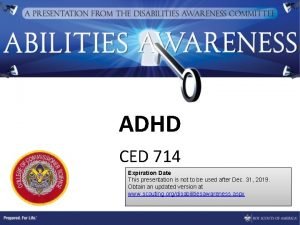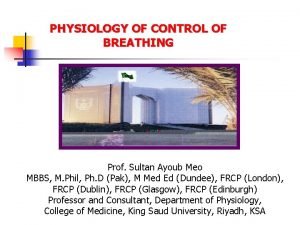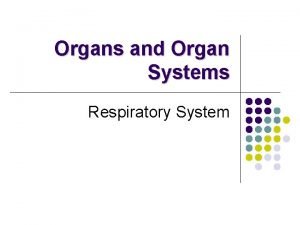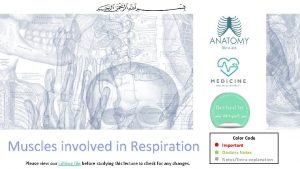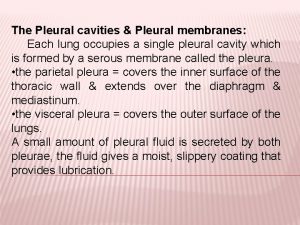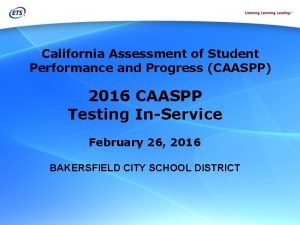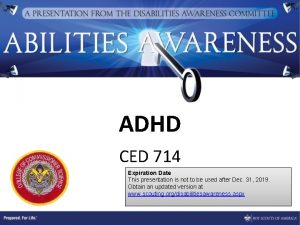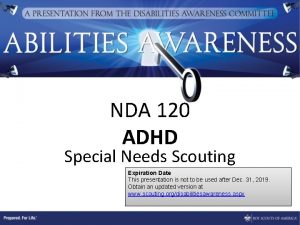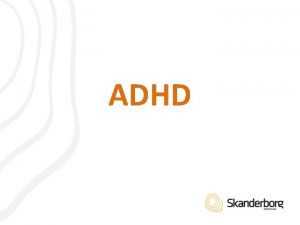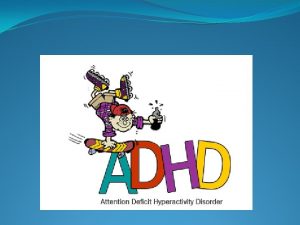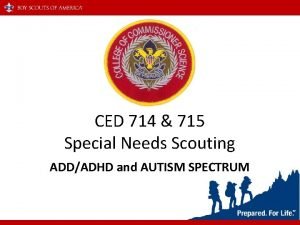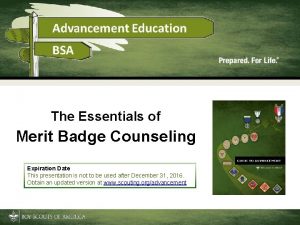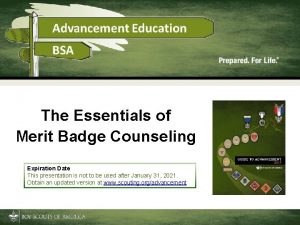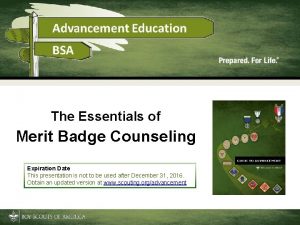ADHD CED 714 Expiration Date This presentation is




















- Slides: 20

ADHD CED 714 Expiration Date This presentation is not to be used after Dec. 31, 2019. Obtain an updated version at www. scouting. org/disabilitiesawareness. aspx

Attention-Deficit/Hyperactivity Disorder The DSM - 5 diagnostic criteria for ADHD is: A persistent pattern of inattention and/or hyperactivity/impulsivity that interferes with functioning or development as characterized by: -Inattention -Hyperactivity and impulsivity

Characteristics of ADHD Hyperactivity Impulsivity Inattention The Tip of the Iceberg Hidden below the surface

Characteristics of ADHD Hyperactivity Physiological Factors Weak “Executive Functioning” Sleep Disturbance Learning Difficulties Impulsivity Delayed Social Maturity Not Learning Easily From Rewards and Punishment Inattention Coexisting Conditions Impaired Sense of Time Low Frustration Tolerance Hidden below the surface

Focus on the Scout’s Strengths! Energetic Bright Creative Enthusiastic Flexible Inquisitive

TIP #1 Getting to know your Scout. • Have a conversation. • Scout’s Strengths • Scout’s Challenges • How the Scout learns best

Leaders Need to Know • Important information about every Scout • Equipment/Assistive Technology needs • Diagnosis/Health issues • Medications • Allergies • Things to avoid

TIP #2 Work with parents on medications. • Regular medication schedule-why? • Responsibility of prescription medication- who? • If state laws are more limiting, they must be followed.

TIP #3 Work with parents on tips for success. • sensitivity issues? • sleeping issues? • issues with large groups?

TIP #4 Time Management ● State your expectations ● Give a time warning ● Break up directions

TIP #5 Complement the Scout whenever you find a genuine opportunity. Ignore minor inappropriate behavior if it is not dangerous or disruptive. Try to “sandwich” correction between two positive comments Give clear and concise limits

TIP #6 Be aware of early warning signs Fidgety behavior may indicate the Scout is losing impulse control. • • Schedule breaks. Use stations or movement for participation. Give the Scout a break token to use. Give a non-verbal or proximity signal to the Scout to focus.

TIP #7 When you must redirect a Scout, • Speak in a calm voice. • Say, “Tell me what happened? ” • Never publicly humiliate a Scout. • Keep your cool.

TIP #8 When a Scout is starting to become more impulsive or aggressive • Use a yellow card/red card system for all Scouts playing. • “Cooling off” zone • Provide an alternate activity

TIP #9 Have Expectations for all Scouts • Expect the Scout with ADHD to follow the same rules as other Scouts. • ADHD is NOT an excuse for uncontrolled behavior.

TIP #10 Offer opportunities for purposeful movement • Leading cheers • Performing in skits • Assisting with demonstrations • Teaching outdoor skills to younger Scouts

Leader actions that can trigger responses • Remember to use the “Golden Rule” • Beware of some reactions that can have negative responses • Some techniques can also “Backfire”

Scouting Is a Great Program for Youth With ADHD

Through systematic Explanation, interactive Demonstration, and Guided practice, Scouting Enables Scouts with ADHD to discover and develop their unique strengths and interests.

Resources: Scouting. org http: //www. scouting. org/scoutsource/boyscouts/thebuildingbl ocksofscouting/disabilities. aspx Children and Adults with Attention Deficit/Hyperactivity Disorder http: //chadd. org Attention Deficit Disorder Association http: //www. add. org Scouting Magazine http: //scoutingmagazine. org/2013/12/help-scouts-adhd-succeed-without -hurting-anyones-feelings/
 Replens cvs
Replens cvs Smartjet
Smartjet Goodies frozen egg product expiration date
Goodies frozen egg product expiration date Ced date
Ced date Dempries
Dempries Inspiration and expiration
Inspiration and expiration Muscles of inspiration and expiration
Muscles of inspiration and expiration Opwekking 714
Opwekking 714 Deparated
Deparated Muscle involved in respiration
Muscle involved in respiration Muscle of inspiration and expiration
Muscle of inspiration and expiration Caaspp pause rules
Caaspp pause rules 115 hangi yüzlüğe yuvarlanır
115 hangi yüzlüğe yuvarlanır Ced greentech sacramento
Ced greentech sacramento Ap chemistry electrochemistry
Ap chemistry electrochemistry Osu
Osu Detectación
Detectación Ced
Ced Aaron cao
Aaron cao Ced
Ced Ced qub
Ced qub



